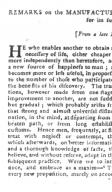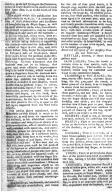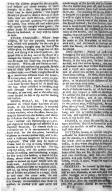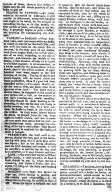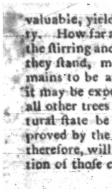[ Remarks on the Manufacturing of Maple Sugar; with Directions for Its Further Improvement ]
Date: 1790/10/03
Source:
Nova Scotia Magazine
Institution: Nova Scotia Archives
| Source Origin: Nova Scotia Newspapers on Microfilm
| Reference: Microfilm Reels 8062, 8063
Instructions for sugar maple sap collection and processing, detailing the necessary building, procedure, and equipment for converting maple syrup to a granular sugar. nn. 249_54. Microfilm Reel 8063. Reprinted from a publication of the same title (Philadelphia: James & Johnson, 1790).
REMARKS on the MANUFACTURING of MAPLE SUGAR; with Directions
for its future Improvement.
[From a late Philadelphia Publication.]
HE who enables another to obtain any
necessary of life, either cheaper or
more independently than heretofore, adds
a new source of happiness to man; and
becomes more or less useful, in proportion
to the number of those who participate in
the benefits of his discovery. The transi-
tions, however made from one stage of
improvement to another, are not sudden,
but gradual; which probably arises from
that strong and almost universal disincli-
nation, in the mind, at departing from the
beaten path, or from long established
customs. Hence men, frequently, at first,
treat with neglect or contempt, that,
which afterwards, on better information,
and a thorough knowledge of facts, they
believe, and without reserve, adopt in their
subsequent practice. Were we to intro-
duce, and embrace as a maxim-- ‘That
every new proposition, merely on account ___
of its novelty, must be rejected’-- our
knowledge would no longer be progressive,
and every kind of improvement must
cease. That the juice of the Sugar Ma-
ple would produce a saccharine substance,
answering the purposes of sugar has been
known many years, and particularly by
the inhabitants of the Eastern States;--
but that there was a sufficient number of
this kind of tree, in the States of New-
York and Pennsylvania, only, to supply
the whole of the United States with this
article, is a fact which was not so well as-
certained, or so satisfactorily authentica-
ted, until within a year or two past;--and
that the sugar of this tree was capable of
being grained, and produced, in quality,
equal to the best imported--was in some
measure problematical until within even
two or three months past, when the arri-
val of several chests in the city of Phila-
delphia, made last spring on the Delaware;
removed every doubt in the minds of those
who have seen it, as to the truth of this
last fact.
The object which this publication has
particularly in view, is, ‘A communica-
tion of such observations and directions
on manufacturing the Maple Sugar, as will
be most useful to those, who, from situati-
on, interest or patriotism, may be induced
to engage in and carry on this business.’--
A person who had, many years, been ac-
quainted with the usual way of making
this article being desirous of improving
the method--obtained the instructions of
a refiner of sugar in this city, and, with
these before him, began his experiments,
in February last, at Stock-port, about
three miles below the junction of the Mo-
hock and Popatchtunck branches of the
Delaware. He soon discovered that the
business was yet in its infancy, that
great and even essential improvements
might be made therein, which would re-
quire a departure from the methods here-
tofore in general use, in boiling down the
green sap, graining the syrup, &c. and
which if attended to and adopted, would
enable him to produce sugar, in colour,
grain and taste, equal, if not superior in
reputation, to any imported. His senti-
ments and hopes, on this head, have
been fully confirmed, by the result of his
experiments; for the sugar he has made,
and sent down to this city, is equal to the
best sugars imported from the West-India
islands.
The person above mentioned, whose
judgment on this subject is much to be
relied on, as well from his experience in
the business, as his established character
for candour and integrity--is clearly of o-
pinion--that four, active, industrious men,
well provided with materials, and conve-
niencies proper for carrying on the busi-
ness, may turn out, in a common season,
which lasts from four to six weeks, forty
hundred weight of good sugar, that is, ten
hundred to each man. If four men can ef-
fect this, how great must be the product
of the separate or associated labours of the
many thousands of people who now inha-
bit, or may inhabit the immense tracts of
lands, which abound with the Sugar Ma-
ple tree! What a new and extensive field
opens from these considerations! What an
interesting and important object to the
cause of humanity, presents itself to our
View! An object that deserves the coun-
tenance of every good citizen, and that
highly merits even national encourage-
ment.
The buildings, implements, and utensils
needful for this manufacture, and suited
___
for the use of four good hands, it is
thought may, together with the best pro-
cess yet known for boiling the sap, gra-
nulating the syrup &c. be usefully point-
ed out, that those persons, who incline to
enter upon it in the next year, may pro-
ceed on the best information to be had,
and timely provide themselves with every
thing necessary for the purpose; particu-
larly, with such articles made of wood,
as require seasoning--Where a larger
number than four men are intended to be
employed at one Sugar Camp,’ the kettles
and other articles to be provided, as well
as the number of trees to be tapped, may
be increased accordingly.
Detail and description of the necessary Uten-
sils and Materials.
KETTLES; Sixteen, of about fifteen
gallons each.
IRON LADLES; Two, the bowls to
contain three or four quarts, each, for
shifting the syrup: The handles to have
sockets, which may be extended with
wood to any convenient length.
TRAMMELS or POT-RACKS; Six-
teen, one for each kettle, eighteen inches
long, the flat part, and the round, or
lower piece of the same, so as to lengthen
to about three feet occasionally.
SCREW AUGERS; Four, of an half,
three quarters, and one inch, for boring
the trees.--Although it has been found
that the Sugar Maple tree will bear much
hardship and abuse; yet the chopping
notches into it from year to year, should
be forborne; an auger hole answers the
purpose of drawing off the sap, equally
well, and is no injury to the tree.
BUCKETS; Eight or ten, of three gal-
lons each, at least, for collecting the sap.
BOARDS; Eight or ten round pieces,
to lay on the surface of the sap, at the top
of the Buckets, to prevent its splashing
over.
COOLERS; Three or four tubs, of a-
bout fifteen gallons each (kettles will an-
swer the purpose) to receive the syrup
from the boilers, when, upon trial from
the proof stick, it draws into a thread be-
tween the thumb and finger, as hereafter
described.
YOKES; Four, to go across the shoul-
ders of the persons employed in collecting
the sap, having a bucket suspended at
each end.
TROUGHS; Eight hundred should be
made of white pine, white ash, water ash,
aspen, linden or bass wood, poplar,
common-maple, or Sugar Maple: Avoid,
for this use, the butter-nut, chesnut and
oak; -- these would either discolour the
sap, or give it an improper taste.--A per-
son, acquainted with the business, can cut
down the timber proper for the purpose,
and hollow out about twenty of these
troughs in a day; they generally hold
from two to three gallons: The largest
should be placed to receive the sap of those
trees that are most thriving, and which
yield the greatest quantity.--It may also
be noted, that white-ash and white-pine
will make the troughs when green; the
other kinds of timber abovementioned,
should be seasoned, or they will be liable
to leak.
STORE TROUGHS: Where large
cisterns, fit for the purpose, cannot be
had, which will generally be the case in a
new country, troughs may be had of the
white-pine, by falling a large tree of that
kind, and fixing it in a level position; the
upper side to be dug out in the shape of a
manger for feeding cattle:--The larger it
can be made for receiving the green sap,
the better. White-ash and linden or bass-
wood will also answer the purpose, should
any of them split and leak they may be
caulked tight.--These troughs should be
at a convenient distance from the boilers,
in a cool place, and under cover, to pre-
vent snow, rain, &c. mixing with the sap.
--A linen strainer should be so fixed that
the sap, when collected in buckets, may
pass through such strainer into these
troughs, at one end, and at the other end,
room should be left to dip out for feeding
the boilers.
SHEDS, WALLS, &c. The exposed
manner in which sugar has been usually
made, in the back country, is attended
with many inconveniences, especially in
windy weather, when the ashes, leaves, &c.
may be blown into the boilers, and there-
by discolour the syrup, or injure its fla-
vour: neither can the keeping up a pro-
per degree of heat be always effected in an
exposed situation. To remedy these in-
conveniences it is recommended that a
back wall, for the fire-place, be erected
eighteen or twenty inches high, and to ex-
tend a sufficient length for all the boilers
employed. This wall may be made of
stones laid in clay or loam, where lime-
mortar is not readily to be had. For sa-
ving the ashes, and the greater conveni-
encies in making and continuing a regu-
ler fire under the boilers, a hearth of flat
stone, about three feet wide, should be
made to extend and equal length with the
back wall. And further to obviate the ill
effects, which too open an exposure is sub-
ject to, (it being observed where a num-
ber of boilers are placed in a range, those
at and near the outer ends, do not
succeed so well as the more central ones)
it is strongly recommended that sheds be
erected, to extend over and cover the
___
whole length of the hearth, and so formed
that the smoke may pass off, and be at the
same time a shelter from high winds, rain,
snow, &c. For graining the syrup, after it
is brought to a proper state in the boilers,
it will be right to have a separate shed or
building in which two of the sixteen kit-
tles should be fixed; for this service, char-
coal is much better than wood, as the heat
or flame should be confined to the bot-
toms of the kettles, and be uniform and
regular, to guard against burning or scorch-
ing. A wall, as above described, should
be made at the fire-place, as well as at
each end; and the hearth or bottom laid
with flat stones, on which charcoal is to
be placed.
AND IRONS: Pieces of cast-iron,
something like and irons, and to serve the
same purpose, will be very useful: They
should, in the long part, be two feet and
an half, and two inches square ; the turn
at the inner end, four inches downwards,
and a small turn upwards, at the outer
end of about two inches, to prevent the
wood from rolling. Of these, there should
be a number to suit the extent of the fire-
place, to be placed at the distance of five
or six feet from each other.
SUGAR MOULDS : These should be
made of seasoned boards, or of such wood
as will not impart a taste to the sugar.
To answer the end of earthen moulds, used
in the West-Indies, and in our refining
houses, the use of sugar moulds has been,
in the present year, well supplied, by ma-
king then of wood, somewhat resembling
a millhopper, about twenty seven inches
long, and ten or twelve inches wide, at
the top, and tapered to the width of one
inch, at the lower end.
FRAMES, to place the moulds in, a-
bove described, should be formed so as to
admit the moulds to rest in them, about
half their depth.
GUTTERS, spouts, or narrow troughs,
--should be fixed within the frames, un-
der the moulds, in a descending position ;
the lower ends to enter covered casks or
vessels, so that when the plugs or stoppers
are drawn from the bottom of the moulds,
which may be done in about twenty-four
hours after they are set, the molasses that
will run therefrom, may fall into these
gutters and pass readily into the covered
vessels, which, if open, would be exposed
to dust and dirt.
PRICKERS : So termed by the sugar-
bakers, about twelve inches long and
half an inch diameter, at one end, and the
other brought to a point ; for want of
iron, they may be made of hard wood :-
A few hours after the moulds are unstop-
ped, the prickers should be run up the
bottom of them, three or four inches, to
make way for the whole quantity of mo-
lasses to pass off.
SEASON for TAPPING:--By trials,
made in the month of February, it will
readily be discovered, when this valuable
tree ought to be bored, for the purpose of
extracting the sap, as in that month, ei-
ther earlier or later, according to the sea-
son, it generally begins to yield a suffici-
ent, quantity for commencing the busi-
ness.
TAPPING or BORING:-- Four hun-
dred trees, each tree bored with two holes,
as nearly as may be on the south side; and
also with two holes on the north side of
the tree, in the early part of the season,
with screw augers from two to four quar-
ters of an inch, according to the size of
the tree; and towards the middle of the
season, a like number of trees to be bored
in the same manner, is recommended, as
a better mode for the management of four
hands, than if the whole number of eight
hundred trees were tapped at the first
running of the sap. The sap of the second
parcel tapped, will be found richer and
more productive, than if a part has been
extracted earlier.--The auger should en-
ter the tree at first, not more than three
quarters of an inch: The holes may at
several times, be deepened to the extent of
two inches and a half, as the manner of
the sap’s running may render necessary.
The hole should be made slanting or de-
scending, so that the sap may run freely in
frosty weather, and not, by a slow mo-
tion, be liable to freeze in the mouth of
the orifice. In these holes, spouts should
be fixed, to project from the tree, from
eight to twelve inches, and not to enter
the tree more than about half an inch: as
the farther they enter, the more the run-
ning of the sap is obstructed: They should
be prepared, in readiness for the season, of
elder or sumach.
PRESERVING the SAP:-- It is ob-
served, that in the early part of the season,
the sap will keep two or three days with-
out injury; but as the spring advances,
and the frost becomes less intense, it will
be necessary to boil the sap the day after
It is collected, or it may ferment and sour.
LIME:--To every half barrel, or fifteen
gallon kettle, a table spoonful of slack’d
lime, should be put in, while the sap is
warming, and before it boils; this pro-
motes the rising of the scum and forming
of the grain.
BOILING:--A smart fire should be
kept up, while the sap is boiling, and
the watery part evaporating. -- As the
scum rises to the top, be careful to skim it
off. When the liquor is reduced one half
___
in quantity, lade the second kettle from
the end, into the end one; and when the
contents of three or four kettles can be
contained in one, then let the whole be
laded into that, at the end; filling up the
empty kettles, without delay, with fresh
sap. As the liquor in the end kettles, re-
moved from those which have been men-
tioned, becomes a syrup, it should be strain-
ed through a good blanket, or woollen
cloth; and care must be taken, not to suf-
fer it to boil too long, so to be too thick
to be strained in this manner. It should,
when thus cleansed from its impurities,
stand in buckets or other suitable vessels,
twelve hours or more, that the particles
of lime, and other remaining sediment,
may settle to the bottom; after which, it
should be so gently poured off into a ket-
tle or boiler, as not to carry with it any of
these settlings. However, they need not
be wholly lost; they will mostly contain
a considerable quantity of sugar or syrup;
by pouring fresh sap on them, stirring
them well together, and suffering them to
stand a while to settle, a great part of the
valuable sweets contained in such sedi-
ment may be saved. It may be further
noted, that when the sap is weak, which
is generally the case towards the latter
part of the season, it requires more boiling
and a higher proof than that collected ear-
lier and of greater strength.
N. B. The method before described was
pursued in the last year, and appeared to
answer well; it is nevertheless believed,
by a judicious sugar-boiler, that it would
be best to avoid letting the syrup stand
twelve hours after being strained through
a blanket: When the process is begun,
the sooner it is compleated, in his opinion,
the better: -- the design of its so standing,
for twelve hours, being chiefly intended
to give sufficient time, for the particles of
lime and other sediment to collect at the
bottom of the kettle.-- It is proposed that
lime should be mixed with a quantity of
fresh sap, in the evening, and be well stir-
red; the large particles of lime, in this
case, will be likely to subside before morn-
ing, and the clear sap so impregnated may
be mixed, the next morning, in proper
proportions, in the several kettles; ob-
serving, however, that in this mode, more
lime will be necessary, as less of its strength
will be extracted by cold than by hot wa-
ter.
GRAINING.--The syrup, having stood
twelve hours, or upwards--is then to be
gently poured into a kettle or boiler as
above-mentioned; which would be best
placed over a fire made of charcoal, as
before hinted; unless the kettle is so fixed
in a furnace, or in such a situation, that
the flame can be confined to the bottom;
for if it be suffered to pass on the sides, it
endangers the syrup’s being burned.--
This operation should also be performed
with a smart fire, to be uniformly and
equally kept up--in which, as well as in
boiling the green sap, the use of butter,
hog’s lard, or other fat, it not only very
useful and advantageous, but absolutely
necessary.-- When, in the course of boiling,
the fat rises towards the top, a piece of
fat equal in size to a nutmeg, thrown in,
will keep it down. Particular care should
be taken to prevent, by these means, the
the rising of the syrup when graining,
which may require a larger proportion of
butter, &c. It is found that the evapora-
tion is much more expeditious, and is be-
lieved the quantity of sugar made, is larger,
when careful guard is kept to prevent the
sap, and particularly the syrup, when
graining, from rising, by the timely intro-
duction of a piece of fat, as above descri-
bed.--To form a judgement when the sy-
rup is sufficiently boiled, take out with
quickness the stirring-stick, which is con-
stantly kept in the boiler, for the purpose
of taking the proof, rub some of the syrup
off the lower end of it, with the thumb,
and if on applying the finger thereto, it
draws into a thread, it may be deemed in
a proper state to be laded into a tub or
cooler. Then it should be forthwith stir-
red, and that incessantly, with a stirring
stick, about three inches broad, until the
grain can be felt between the finger and
thumb, when it is in a fit state to be
poured into moulds. The managing
a sugar-works in the West-Indies, and in
the refining houses in North America, has
been found to require much judgment and
experience, to conduct the business to the
best advantage; indeed, it seems hardly
possible, to communicate to persons who
have little knowledge of the matter, and
in terms clearly to be understood, full in-
formation, as to the different appearances
of the syrup, in the time of boiling, and
to point out the moment when some
material movements or changes ought to
be made; nevertheless, from the forego-
ing hints and directions, which are ground-
ed on observation and experience, it is
hoped, much use may be derived, and that
from year to year, greater advances and
Improvements may be made in this valua-
ble business.
CLAYING or WHITENING the SU-
GAR:-- To promote the molasses passing
more freely from the sugar, when drain-
ing in the moulds, and to improve its co-
lour, in two or three days after the moulds
are unstopped at the lower end, mix white
clay with water, so as to reduce it to a
___
thin mortar; with this cover the top of
the moulds one inch and a half thick,
when this covering appears dry, remove it,
and supply the place with a fresh covering
of about two inches thick.
Although it is apprehended the use of
clay, as above set forth, particularly in the
latter part of the season, will be found be-
neficial, it may, however, be prudent to
continue or decline the practice, according
to the effect or use it appears to be of on
a careful trial: The quantity of clay must
be proportioned to the manner in which
the sugar has been boiled; if high boiled,
it will require much more clay than if boil-
ed low. It is also thought that the use of
clay lessens the quantity of sugar, perhaps
one fifth part, and may be more or less
according to the knowledge of the person
who undertakes the business. And it may
be further remarked, that if the quantity
of sugar be lessened in weight, by claying,
one fifth part, it is not to be concluded
that the whole of the fifth part will be e-
ventually lost; there will be more syrup
than there otherwise would have been, in-
dependent of the water from the clay that
passes through the sugar.
MOLASSES and VINEGAR.--When
the trees of the second tapping become
poor, in quantity and quality, which may
be about the tenth of April, or perhaps
sooner, then a number of fresh tapped trees
will yield a sap, of which may be made
good molasses, and also excellent vinegar.
In all sugar plantations, it will be ad-
vantageous to cut out the different sorts of
timber, which grow intermixed with the
sugar Maple, and even those of that species
which are not thriving, promising trees.
The timber so cut out will serve for fuel
for the boilers, and leave greater openings
for the rays of the sun to enter, which will
have a tendency to improve and enrich the
remaining trees. The ground so cleared
of all except the maple tree, it has been
observed, is particularly favourable for
pasture and the growth of grass. ‘Whe-
ther this tree is injured or impoverished by
repeated tappings,’ is an enquiry to be ex-
pected, and has been frequently made, of
late, by persons, who have anxiously
wished for the success of this business.
It has been before observed, that it will
bear much hardship and abuse, and it may
be added, that there are instances, parti-
cularly among the old settlements on the
North River, of trees which have been
tapped for fifty years or upwards, and
continue to yield their sap in the season,
equal to any brought in use of later time;
indeed it is asserted, with confidence, by
persons who have had some years experi-
ence, that these trees, by use, become more
valuable, yielding a sap of a richer quali-
ty. How far a careful cultivation of them,
the stirring and manuring the soil in which
they stand, may improve their value, re-
mains to be ascertained in future, though
it may be expected that this, like almost
all over trees and plants, may from a na-
tural state be greatly and essentially im-
proved by the hand of art. Experiments,
therefore, will not be unworthy the atten-
tion of those citizens, situated in the more
__
interior parts of the States, if it shall,
thereby, be found that these trees can be
readily propagated, either from the seed or
young plants, and be brought to thrive, so
as to be equal in their product, if not su-
perior, to those who have been strewed o-
ver the country, without the aid of man.
To what an extent of cultivation may not
this lead! There will be no risk or disad-
vantage attending the experiment; and it
certainly deserves encouragement.
Download: Transcription | Images
